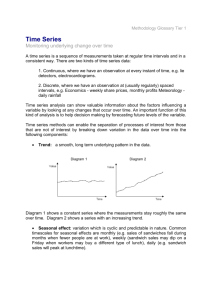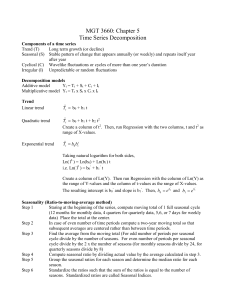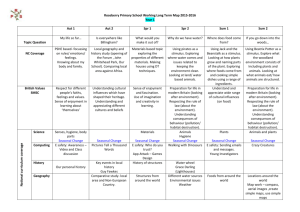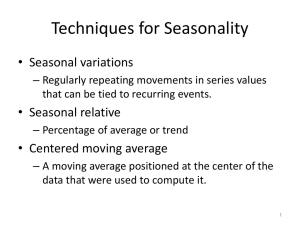Modeling and Forecasting Seasonality
advertisement
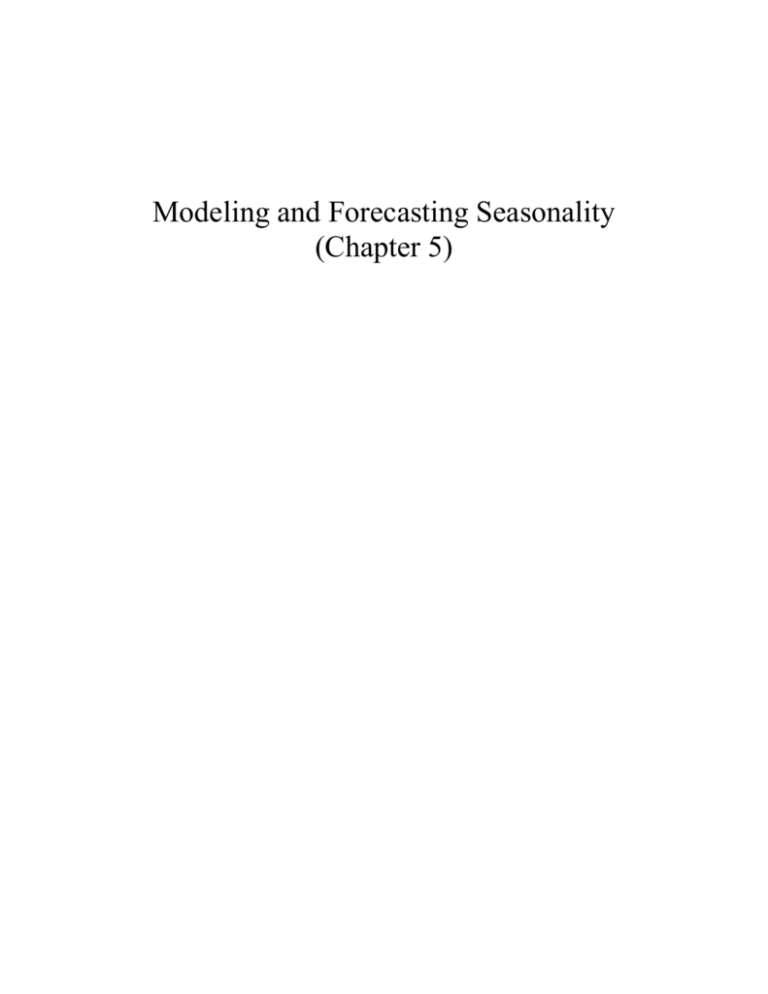
Modeling and Forecasting Seasonality
(Chapter 5)
Recall that according to the unobserved
components model of a time series, the series yt
has three components: a time trend (Tt), a
seasonal component (St) and a cyclical
component (Ct), so that
yt = Tt + St + Ct
Seasonality refers to the annual cyclical
variation in a time series, which may due to
weather patterns, holiday patterns, school
calendar patterns, etc.
For example, there are cyclical peaks in U.S.
retail sales and employment during the last
quarter of each calendar year due to the holiday
shopping season and there are cyclical troughs in
U.S. housing starts during the winter months of
each calendar year due to weather patterns.
Illustrations of time series with seasonal
variation are presented in the textbook (Figures
5.1, 5.2, and 5.3).
Most of the time series that you have
selected for your study have been seasonally
adjusted. That is,
ySA,t yt Sˆt
where Ŝ t is an estimate of the seasonal
component of yt. (Or, in some cases, your
series has not been seasonally adjusted
because it does not display a seasonal
pattern.)
Why are time series usually presented in
seasonally adjusted form?
Typically, our interest in a macroeconomic time
series is in the information it provides about the
overall state of the economy and the direction
the economy is heading.
Suppose we did not seasonally adjust our data
and we observe a huge increase in retail sales
during the fourth quarter of 2005. Should we
interpret this as a sign that the economy is
suddenly booming? Or, suppose I we observe a
huge increase in the unemployment rate during
May/June of 2006 (after schools let out and
there is a large temporary increase in the
economy’s labor force). Should I interpret this
as a sign that the economy and its labor market
are suddenly deteriorating?
In both examples, the answer is no, unless retail
sales are growing by more than normal for that
part of the year or unless the unemployment rate
is increasing by more than normal for that part
of the year.
Seasonally adjusted data are meant to
smooth out the data to remove the regular
ups and downs that are associated with the
seasonal cycle. So, if seasonally adjusted
retail sales increase during the fourth quarter
or if the seasonally adjusted unemployment
rate increases during May/June we can
interpret these as movements beyond the
movements that are part of the normal
seasonal cycle.
While the macroeconomist, government
official or business person may be interested
in the behavior of seasonally adjusted time
series, there are many business forecasting
settings where the seasonal component of
the series is fundamentally important and
seasonally adjusted data would be
inadequate and inappropriate.
A bank may be interested in forecasting
housing starts in its area (or, if the bank is
large enough, at a national level) in order to
anticipate the demand for mortgage loans.
Or a business that provides building supplies
to homebuilders may need to forecast
housing starts to anticipate the demand for
its products and make current inventory
decisions. These forecasters will be
interested in predicting housing starts
including the seasonal component.
In these cases, you would want to use
seasonally unadjusted data, model the
seasonality and forecast it, along with
forecasts of the trend and cyclical
components.
Modeling Seasonality –
Recall from our discussion of the trend that
there are two approaches to modeling the
trend of a time series.
One approach, which is the approach we
used, is to assume that the trend is
deterministic, i.e., it can be modeled as an
exact or perfectly predictable function of
time (although we may not know the exact
form of that function or the parameters of
the function). A second (and more
complicated) approach, which we may
discuss later in the course, is to assume that
the trend is stochastic, i.e., the trend
component evolves in a way that is subject
to random disturbances.
Similarly, there are two approaches to
modeling seasonality - deterministic
seasonality and stochastic seasonality which differ according to whether St is
perfectly predictable or is subject to random
disturbances.
We will assume that the seasonal component
is deterministic.
A straightforward and commonly used
approach to modeling seasonality (which is,
however, not the method governement
agencies typically use to seasonally adjust
data) is to specify a seasonal dummy model.
Suppose you are working with quarterly data
and want to allow each quarter to have a
distinct seasonal effect on the series.
Consider
St = γ1D1t + γ2D2t + γ3D3t + γ4D4t
where
D1t = 1 if t = quarter 1
= 0 if not
D2t = 1 if t = quarter 2
= 0 if not
D3t = 1 if t = quarter 3
= 0 if not
D4t = 1 if t = quarter 4
= 0 if not
So, St = γ1 if t = quarter 1,…, St = γ4 if t =
quarter 4.
{An equivalent model –
St = γ1 + γ2D2t + γ3D3t + γ4D4t
where D2, D3, and D4 are as defined above.
In this case, St = γ1 if t is in quarter 1,
St = γ1 + γ2 if t is in quarter 2,…, St = γ1+γ4
if t is in quarter 4.}
If you are working with monthly data and
want to allow a distinct seasonal effect for
each month,
St = γ1D1t + γ2D2t + … + γ12D12,t
where
Dit =1 if month t is the i-th month of the year
= 0 if not
{or, St = γ1 + γ2D2t + … + γ12D12,t, where
D2,…,D12 are as defined above.}
Suppose you have monthly data but you
only want to allow for quarterly seasonal
variation?
St = γ1D1t + γ2D2t + γ3D3t + γ4D4t
where
Dit =1 if month t is in the i-th quarter of the
year
= 0 if not
{Or, St = γ1 + γ2D2t + γ3D3t + γ4D4t}
Suppose you are working with data, say
monthly data, and you think that there is
only one month that is different from the
other months. Say, for example, that the
seasonality is the same for months 1-11 but
is different than the seasonality for month
12St = γ1D1t + γ2D2t (or, St = γ1 + γ2D2t)
where
D1t = 1 if t is in month 1,2,…,11
= 0 if t is in month 12
and
D2t = 1 if t is in month 12
= 0 if t is in month 1,2,…,11
Many monetary and finanicial time series
are weekly or even daily (or hourly or…). if
you are working with weekly or daily data
you normally would not specify a separate
seasonal for each week or day. We could,
however, still allow for monthly or quarter
seasonal variation in our weekly data. For
example to allow for a monthly seasonal
pattern in our weekly series:
St = γ1D1t + … + γ12D12,t
where D1t =1 if week t falls in the first
month of the year, …., D12,t = 1 if week t
falls in the 12th month of the year.
More generally, regardless of the frequency
of the data (quarterly, monthly, weekly, …)
we can divide the year up into s seasons and
define the seasonal component according to
St = γ1D1t + … + γsDs,t
where Dit = 1 if observation t falls in annual
period i (and is equal to zero if not).
Some other extensions:
Suppose we are working with monthly data and
we are allowing for quarterly seasonal variation
but also want allow for a December effect –
St = γ1D1t + … + γ4D4,t + γ5DECt
where DECt =1 if t is a December (and is equal
to zero if not).
Then,
St = γ1 for t = January, February,March
St = γ2 for t = April, May, June
St = γ3 for t = July, August, September
St = γ4 for t = October and November
St = γ4+γ5 for December.
Your text also discusses extensions of this sort
for “holiday variation” and “trading-day
variation”, the latter being particularly important
in modeling seasonality in high-frequency
financial time series.
For our purposes, we will focus on simple
seasonal models of the form
St = γ1D1t + γ2D2t … + γsDs,t
or, equivalently,
St = γ1 + γ2D2t … + γsDs,t
where we have have divided the year into s
parts.
To estimate the seasonal model and the
seasonal component of yt it is most
straightforward if we detrend and
deseasonalize simultaneously –
Let
Tt = β0 + β1t + … + βptp
and
St = γ1 + γ2D2t … + γsDs,t
so that
yt = β0 + β1t + … + βptp + γ1 + γ2D2t … + γsDs,t + εt
where εt is the cyclical component of yt.
Notice that the model
yt = β0 + β1t + … + βptp + γ1 + γ2D2t … + γsDs,t + εt
has a redundant parameter, since it has two
constants, β0 and γ1.
According to this model of trend and
seasonality, the nature of the seasonality is
that the intercept of the trend line differs for
each season.
Eliminating γ1 from the model has no
consequence since the intercept for season 1
is accounted for by β0. So the model can be
written
yt = β0 + β1t + … + βptp + γ2D2t … + γsDs,t + εt
We can estimate the parameters of this
model by OLS, regressing y on a constant,
t,…,tp, D2t,…,Dst, for t = 1,…,T yielding:
yt ˆ0 ˆ1t ... ˆ p t p ˆ2 D2t ... ˆs Dst ˆt
where the β-hats are the OLS estimates of
the β’s and the ε-hats are the OLS residuals
ˆt yt ˆ0 ˆ1t ... ˆ pt p ˆ2 D2t ... ˆs Dst
and form the estimated cyclical component
of the yt’s.
{Question – After you estimated this model,
how would you test whether there is any
seasonality in the original y series?}
Forecasting yT+h
According to our model,
yT+h = β0 + β1(T+h) + … + βp(T+h)p + γ1 + γ2D2,T+h +
… + γsDs,T+h + εT+h
and so our forecast of yT+h formed at time T
will be:
yˆT h,T ˆ0 ˆ1 (T h) ... ˆ p (T h) p ˆ2 D2,T h ... ˆs Ds ,T h ˆT h,T
where ˆ
time T.
T h ,T
is our forecast of εT+h formed at
If the ε’s are i.i.d. with mean zero, then
ˆ
= 0 and
T h ,T
yˆT h,T ˆ0 ˆ1 (T h) ... ˆ p (T h) p ˆ2 D2,T h ... ˆs Ds ,T h
If the ε’s are i.i.d. N(0,σ2) then, ignoring
parameter uncertainty,
1.
yT h yˆ T h ,T
N (0,1)
ˆ
where
T
1
ˆ
ˆt2
T ( p s ) t 1
2
and
2. yˆ T h ,T 1.96ˆ
is a 95% forecast interval for yT+h.

